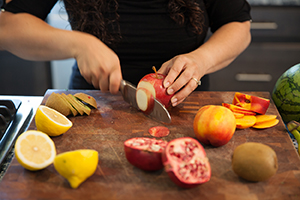Adding Flavor to Low-Fat Meals
There are endless ways to add more variety and flavor to your diet. You don’t need salt or high-fat additions.

-
Keep plenty of fresh fruit on hand. Try adding it to your main dishes. For example, peaches or apples go well with chicken. They can be very flavorful in casseroles or with roasted poultry. Bananas or raisins add flavor to curry dishes with a Caribbean theme.
-
Buy fruits and vegetables you haven’t tried before. Often, recipes or suggestions for their use will be listed in the produce section at the grocery store. This is often the case with more exotic or rare foods. Peppers can add sweet or hot characteristics to your dish.
-
Go to the cookbook section at the bookstore or library. Many of the unique flavors we associate with Thai, African, or Caribbean dishes come from the seasonings used in their recipes. Try one new recipe a week. You’ll soon know what spices to add to a dish to give it the taste of exotic places.
-
Marinate meats, poultry, and fish before grilling or baking. Try mixtures of wine, fruit juice, low-sodium tomato juice, vinegar, lemon juice, herbs, and spices. Be aware that soy sauce and teriyaki sauce are high in sodium. Use low-sodium versions, and use less of them. Ginger, dry sherry, and sesame seeds can add Asian flavors to foods.
-
Swap in low-fat condiments. Instead of high-fat condiments and sauces, add flavor to your meals with low-fat condiments, such as salsa, horseradish, mustard, chutney, wasabi, or bean puree. A little can go a long way!
-
Use high-heat cooking. Consider cooking meat, poultry, and fish by pan-searing, grilling, or broiling. These methods use high heat and add flavor.
-
Hit the juice. Add citrus juice or peel to help boost flavor.
-
Grill it up. Grilling vegetables adds a different layer of flavor than other cooking methods.
© 2000-2024 The StayWell Company, LLC. All rights reserved. This information is not intended as a substitute for professional medical care. Always follow your healthcare professional's instructions.